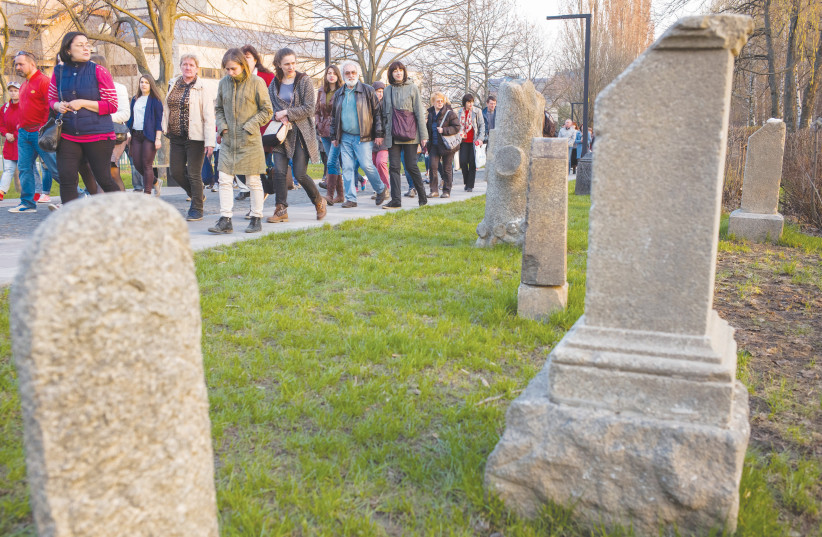Volume of ex-USSR new migrants leaps past Africans
By YONAH JEREMY BOB, JPOST
JEWISH GRAVES in Ukraine.(photo credit: REUTERS)
The first ever report by the special appeals court system for migrants was issued on Sunday, noting that the volume of new Ukrainian and Georgian illegal migrants in 2018 far outpaced those of African origin.
Established in 2014 to lighten the case load on the District Courts – which were becoming swamped with a spike in cases of Africans who came to Israel illegally but claimed refugee status – it has been difficult to follow the migrant courts.
Proceedings in the courts are not publicized as well as proceedings in other courts, and most results are obtained by the media only when an NGO or specific lawyer involved chooses to provide them.
The report marked the first attempt by the migrant courts at greater transparency – and probably also signals an understanding by the court system and the state that dealing with legal question relating to migrants is not a passing phase.<
>
Most Israeli politicians, besides those in Meretz, have supported different efforts by the state to get illegal migrants to leave the country, whether they might be technically entitled to refugee status or not.
Critics in the human rights community have framed the migrant courts as less independent and less concerned with human rights than judges at the higher levels.
Generally, a case reaches the courts when a migrant files with the state for refugee status and is rejected, but the courts deal with a variety of other issues relating to migrants’ rights.
Migrants can then appeal to the migrant courts. Some cases can also be appealed from the migrant courts to the district courts or even to the High Court of Justice.
Still, the state maintains that having the migrant courts serve as the court of first instance is a way to dilute the case load of the other courts.
Even if an appeal reaches those higher courts, the proceeding is shorter since it is based on the longer evidentiary record collected at the first level.
The report noted a spike in Ukrainian and Georgian illegal migrants to Israel.
Due to the spike, in 2018, 857 Ukrainians and 663 Georgians were being held in special illegal migrant detention centers, making up 61% of all migrants in detention.
When adding in smaller numbers of illegal migrants from other former USSR states, they make up around 70% of all migrants in detention.
According to the report, the courts opened 5,889 cases in 2018, a jump of 22% compared to 2017.
The report also said that the courts closed 4,851 cases and that another 2,756 cases were still being handled.
The cases waiting for a decision include around a thousand cases which were appealed to the High Court in parallel by Sudanese Africans.
A large number of Darfurian Sudanese have filed appeals from migrant court rulings.
Since the courts were founded, they have closed about 17,000 of the approximately 20,000 cases filed.
Next, the report said that 3,506 of the cases specifically related to requests for refugee status.
There was no distinction in the report’s statistics between migrants who came to Israel illegally in 2018 versus those who may have been in Israel for years, but who only now were reaching significant legal points.
However, based on the dramatically lower number of African migrants arriving in Israel in recent years, most of the cases probably involve migrants who have been here for some time.
For example, whereas around 6,800 African migrants entered Israel in 2011 before a fence was in place along the entire Israeli-Egyptian border, only about 50 entered in 2018.
Some 6% of the courts’ rulings came out in favor of migrants.
The Head of the migrant courts, Michal Tzuk-Shafir noted that only nine of the courts’ twelve judicial spots were filled in 2019 due to the lack of a government and an updated budget to provide them funding for the remaining three positions that have been authorized in principle.
There are approximately 30,000 African migrants, including about 22,000 from Eritrea, 6,000 from Sudan and 2,000 from other African countries.
Most Eritreans claim that they cannot return home without facing persecution, while most Sudanese have said they cannot return home because there are no diplomatic relations between the countries.
To date, changes in the stability of Eritrea and Sudan – as well as relations between Israel and Sudan – have not opened up either state to accepting back the almost 30,000 African migrants in Israel, some in the country for well over a decade.




Leave a Reply
You must be logged in to post a comment.